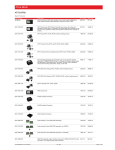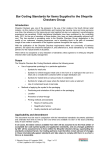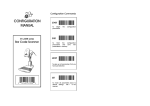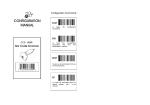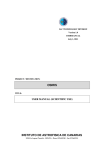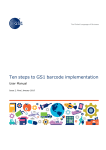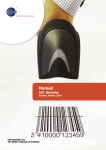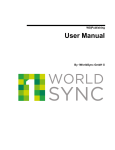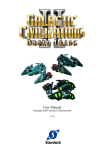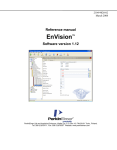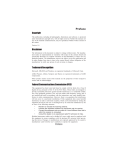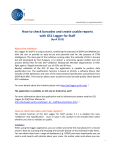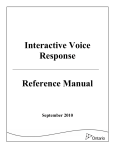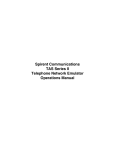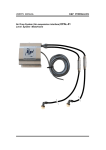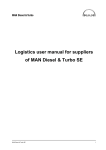Download We have developed a unified standard for the identification and
Transcript
Standard for the identification and labelling of products in the PHS Industry (Heating, Plumbing and Sanitary) Version 1.00 | 26. 09. 2012 Introduction This document defines the standard for uniform identification and labelling of F-packs (consumer units), D-packs (trading units) and T-packs (transport units / pallets) in the PHS Industry (Heating, Plumbing and Sanitary) in Norway. The purpose of this concept is to provide the basis for the efficient flow of goods and information in the value chain for PHS goods. This will simplify product identification in the flow of information, labelling for manufacturers and suppliers, shipping at carriers and shipping agents, and the receipt of goods at the wholesaler, retailer, warehouse, and craftsman or construction site. A precondition for the labelling concept described in this document being implemented in the PHS sector is that there are procedures in place for the exchange of all the necessary basic data between the players in the value chain. The Norwegian Association of the Sanitary and Heating Wholesale Trade (NRF)’s product database www.vvsnrf.no som skal anvendes for tilgjengeliggjøring av grunndata i bransjen will be used as the source of basic data in the sector. This document requires that the packaging levels F-pack (consumer unit), D-pack (trading unit) and T-pack (transport unit / pallet) are defined for the products. F-packs are the units that consumers purchase in PHS retail outlets or from a craftsman or contractor. D-packs and T-packs are types of outer packaging. These are logistical units used in connection with shipping in the value chain. F-packs should be labelled with both their NRF number and their GTIN (Global Trade Item Number), as well as with the manufacturer or supplier’s own item number (optional). The NRF number must appear in humanreadable form (digits), while the GTIN must appear both in human-readable form and as a barcode. The minimum packaging level, F-pack (consumer unit), is identified with the industry’s NRF number. This number is the recommended product identification in day-to-day trade between players in the value chain. This applies primarily to situations where communication is verbal or ”manual” (phone, fax, in-store, Internet, etc.) In situations where product identification and communication are completely electronic (EDI, XML, barcode scanning, etc., but not e-commerce), the GTIN number must be used. The same applies to communication on packaging levels higher than F-pack (there is no other unique identification here). The individual product levels are identified by their GTIN – Global Trade Item Number. It is a condition that the product packages are assigned their own GTIN and are barcoded in accordance with the rules. This document provides a detailed description of the GTIN, how it is constructed and the rules for changing the GTIN. This document also provides recommendations on labelling of the various packaging levels. The labelling concept includes both product information and transportation information. 2 Contents 1 Packaging levels for PHS goods 4 2 General rules on identification and barcoding Identification of products – F-pack, D-pack and T-pack Barcoding products Identification of transport units (packages) 6 7 8 9 3 4 Product labelling of standard PHS goods F-pack labelling D-pack labelling T-pack labelling 10 11 14 16 Transport data labelling 19 Appendix 1 Barcoding using GS1-128 23 3 1. Packaging levels for PHS goods VPHS goods are categorized into the following packaging levels (All packaging levels can be sold at all levels in the PHS Industry): F-pack ”Consumer unit”: the unit usually purchased by consumers and that is scanned at a retail outlet check-out (POS – point of sale), or bought from a craftsman or contractor. In the PHS Industry), this is often called the smallest saleable unit. F-packs can be single-item packs or multi-packs. D-pack ”Trading unit” (box): in the PHS Industry, unit that can be bought from the manufacturer or supplier, wholesaler, shop, warehouse or construction site. D-packs contain several F-packs. (There are also some special varieties of D-packs). T-pack ”Transport unit” (e.g. pallet): the unit that is transported between the actors in the value chain. T-packs usually contain several D-packs, but in some cases may contain only F-packs. 4 Packaging levels for PHS goods PHS goods are categorized into the following packaging levels (All packaging levels can be sold at all levels in the PHS Industry: F-pack T-pack D-pack Only F-pack 5 2. General rules on identification and barcoding Identification of products – F-pack, D-pack and T-pack In the PHS Industry, products are identified by means of an NRF number written in human-readable form and a GTIN (Global Trade Item Number) in the form of a barcode and in human-readable form. The NRF number is the Norwegian PHS Industry’s own seven-digit numbering system for identification of products. Suppliers can order products and register relevant information at www.vvsnrf.no. GTIN is a global numbering system that ensures unique identification of products. A GTIN can have up to 14 digits. All packaging levels: F-packs, D-packs and T-packs must have a unique GTIN. GTIN can have the following formats: GTIN-8 Used for small products (F-packs) GTIN-12 Used in the USA and Canada (F-packs, D-packs and T-packs) GTIN-13 Used for F-packs, D-packs and T-packs GTIN-14 Used for D-packs and T-packs. Not for F-packs Examples of bar codes EAN-8EAN-13UPC-AITF-14 Actors who receive and sell products from PHS suppliers, both nationally and internationally, must be able to handle the NRF number and all types of GTIN. NRF number: The standard rule is that NRF numbers are used only for F-packs. If a supplier wants to establish their own numbering system for their own packages, this can also be done via the NRF database. For F-packs, GTIN-13, GTIN-12 or GTIN-8 is used. GTIN-13 is the most commonly used and is the preferred choice in the PHS Industry. For D-packs and T-packs (outer packaging), all types GTIN can be used i.e. GTIN14, GTIN-13, GTIN-12 or GTIN-8 (uncommon). GTIN-13 and GTIN-14 are most common on outer packaging. NB! For suppliers who need to number and label their products, we recommend the use of GTIN-13 in addition to the NRF number. This applies on all packaging levels, i.e. F-pack, D-pack and T-pack. For more information about the composition and structure of GTINs and labelling, please refer to • GS1 Global User Manual (http://www.gs1.no/sfiles/6/75/80/5/file/gs1_globalusermanual.pdf ) • GS1 Europe Logistics Label (http://www.gs1.no/sfiles/1/85/80/5/file/gs1_europe_logistic_label.pdf ) These documents can be obtained from GS1 Norway or can be downloaded from GS1 Norway’s website www.gs1.no. 6 General rules on identification and barcoding Rules for changing the GTIN If changes are made to existing products, the question often arises of whether the product needs to be assigned a new GTIN or whether it can keep its existing GTIN. As a general rule, if the contents of a package change (net weight or number of units in the package), the package must be assigned a new GTIN. In connection with changes in design or price changes, the existing GTIN is retained. You can find detailed rules for when a product must be given a new GTIN and when it can keep its existing GTIN on GS1’s website under ”GTIN rules”: http://www.gs1.org/1/gtinrules/. Rules for changing the NRF number If changes are made to an existing product that does not affect the properties of the product, it is not usually necessary to change the NRF number. This also applies in the event of a change in the place of manufacture. One advantage of this is that a product can have the same NRF number for an extended period. For questions about whether it is necessary to change an NRF number or not, contact NRF. Barcoding of products Generally speaking, the GS1 System offers the following three barcode symbols for barcoding of the GTIN on F-packs, D-packs and T-packs: 1. The EAN / UPC symbol 2. The ITF-14 symbol 3. The GS1-128 symbol For suppliers who have to barcode the GTIN on their products, we recommend use of the following: EAN/UPCITF-14 GS1-128 GTIN F-pack Recommended Not allowed Not allowed GTIN D-pack Recommended On uneven surfaces To include additional information GTIN T-pack Recommended On uneven surfaces To include additional information For more information, please refer to GGS1 Europe Logistics Label (http://www.gs1.no/sfiles/1/85/80/5/file/gs1_europe_logistic_label.pdf ). 7 General rules on identification and barcoding The EAN / UPC symbol The EAN / UPC symbol consists of the symbols EAN-8, UPC-A (USA and Canada) and EAN-13. Suppliers who have to barcode the GTIN-13 number should use the EAN-13 symbol. We recommend that the EAN-13 symbol is used on all packaging levels, i.e. F-pack, D-pack and T-pack. Very small products (F-packs) are numbered with GTIN-8 and barcoded with the EAN-8 symbol. EAN-13 symbol with a GTIN-13 The ITF-14 symbol The ITF barcode symbol can only be used on D-packs and T-packs (outer packaging). Normally the ITF symbol is used in cases where the EAN / UPC symbol cannot be read properly; for example, on uneven surfaces (e.g. corrugated cardboard). Note that the ITF symbol consists of 14 digits. An initial zero (0) must therefore be added to a GTIN-13 when it is to be barcoded with an ITF-14 symbol. Manufacturer's name / logo Kitchen tap, 20 pcs. GTIN 7012345100010 NRF no. (on F-‐pack) 1234567 Suppliers item no. 30001 The GS1-128 symbol The GS1-128 barcode symbol allows additional information to be included in a single barcode. 8 General rules on identification and barcoding Quality of the barcode symbols It is a requirement that the quality of the barcode symbols used in the PHS Industry (EAN / UPC, ITF and GS1-128) as a minimum comply with “Grade C” print quality according to the Standard ISO/IEC15416. The barcode symbol must be legible at all stages of the value chain and for the duration of the product’s lifetime, i.e. for as long as the product is for sale. Identification of transport units (packages) In the PHS sector, transport units (packages) are identified by means of SSCC codes (Serial Shipping Container Code). SSCC is a global numbering system that ensures unique identification of transport units. The SSCC has a fixed length of 18 digits. SSCC codes are barcoded using the GS1-128 barcode system. Each transport unit must have its own unique SSCC code. The SSCC code is used by carriers in Norway for the unique identification of goods. Read more about labelling for transport in section 4. SENDER RECIPIENT'S ADDRESS TRANSPORT INFO. Gross w eight: 6 00 k g Buyer's ref: X XX334 SSCC: 3 70701230000000120 9 3. Product labelling of standard PHS goods F-pack labelling The following information must be used when labelling F-packs (consumer units): The NRF number in human-readable form and the GTIN in human-readable form and as a barcode. F-packs must be labelled with an NRF number and a GTIN. This applies to all products. This means that the product must be allocated an NRF number and a GTIN even in cases where it is not physically possible in practice to label the product with this number. Product description The product description of the item must appear in human-readable form on the F-pack product label. It is recommended that this product description is based on the product description that has been registered in the NRF product database and must include the product’s name, properties (brand, model, dimensions and any other relevant characteristics that help identify the product) and any trade mark text. If the F-pack is an orderable item, the product description on the F-pack must be the same as the product description on the order confirmation, delivery note or invoice from the supplier / product owner. Brand owner The name of the brand owner must appear in human-readable form on either the label or packaging. Practical guidelines for labelling F-packs F-pack labels – size, design and location: Product information can either be printed on a label that is affixed to the packaging or be printed directly on to the packaging. Since F-packs can vary in both shape and size, the size and design of the label will also vary. The placement of the label must be seen in context with the location of the barcode symbol. See GS1 Global User Manual(http://www.gs1.no/sfiles/6/75/80/5/file/gs1_globalusermanual.pdf ). The barcode symbol on F-packs – size and location The EAN-13 symbol must be used to barcode F-packs. An exception is made for products that are so small that it is not possible to use an EAN-13 symbol. In these cases, the GTIN-8 number and EAN-8 barcode symbol must be used if the product is to be labelled. It is recommended that all products are barcoded. For detailed information about the size and placement of the barcode symbol, see GS1 Global User Manual(http://www.gs1.no/sfiles/6/75/80/5/file/gs1 _globalusermanual.pdf ). Location of the barcode symbol on bundles of pipes or pipes We recommend that for bundles of pipes or pipes the barcode symbol be placed high on the side, centred on the middle of the pipe. 10 Product labelling of standard PHS goods Example of a GS1 product label for an F-pack with an EAN / UPC symbol. If the product is small, as a minimum the GTIN must appear on the label. D-pack labelling NRF number and GTIN D-packs (trading units) must be labelled with an NRF number and a GTIN. We recommend the use of GTIN-13, but GTIN-14 may be used if preferred. Product description The product description must be written in human-readable form on the D-pack product label. The product description must be based on the product description that has been registered in the NRF product database and must include the product’s name, properties (brand, model, dimensions and any other relevant characteristics that help identify the product) and any trade mark text. The product description on D-packs must be the same as the product description in the order confirmation, delivery note or invoice from the supplier / product owner. Brand owner The name of the brand owner must appear in human-readable form, on either the label or packaging. Additional product information is optional. The supplier’s item number can be written in human-readable form. Batch or lot no. This is a number that is generated by the manufacturer and is used to achieve full traceability in the value chain in relation to production and packing of the product. The batch or lot number must be written both in human-readable form and using a GS1-128 barcode symbol in cases where this is necessary in order to link the product to a certificate or a specific production. Date If desired, the production date, packing date and best-before dates can be indicated both in humanreadable form and using a GS1-128 barcode symbol. 11 Product labelling of standard PHS goods Practical guidelines for labelling D-packs D-pack labels – size, design and location. Product information can either be printed on a label that is affixed to the packaging or be printed directly on to the packaging. D-packs require only one product label. The label shall be placed on one of the vertical sides of the D-pack. It is recommended that all D-pack labels are on the same side as the T-pack labels (consistent orientation). Location of the barcode symbol on bundles of pipes We recommend that for bundles of pipes the barcode symbol be placed high on the side, centred on the middle of the pipe. Since D-packs can vary enormously in both shape and size, the size and shape of the label will also vary. The placement of the label must be seen in context with the location of the barcode symbol. See GS1 Europe Logistics Label (http://www.gs1.no/sfiles/1/85/80/5/file/gs1_europe_logistic_label.pdf ). The barcode symbol on D-packs – size and location D-packs shall be marked with one of the following barcode symbols • The EAN-13 symbol – recommended • The ITF-14 symbol – on uneven surfaces, such as corrugated cardboard • The GS1-128 symbol – if the barcode is to include additional information other than the GTIN The EAN-13 symbol is recommended if only the GTIN is to be marked in barcode form on the packaging; the ITF-14 symbol can be used on uneven surfaces, such as corrugated cardboard. The GS1-128 symbol must be used if the barcode is to include additional information other than just the GTIN, for example, the batch or lot number, and/or a best-before date. Regarding the size and placement of these barcode symbols, see GS1 Europe Logistics Label (http://www.gs1.no/sfiles/1/85/80/5/file/gs1_europe_logistic_label.pdf ). 12 Product labelling of standard PHS goods Example of a GS1 product label for a D-pack with an EAN / UPC symbol Example of a GS1 product label for a D-pack with an ITF-14 symbol 13 Product labelling of standard PHS goods T-pack labelling In this specification, we differentiate between two different types of transport units (T-packs), depending on the contents of the unit. Standard T-packs. A T-pack unit containing the same product (same NRF no. / GTIN) with a fixed number of D-packs and where labelling of unambiguous product information on the T-pack is possible. T-packs with different products (mixed pallet). This is a unit that contains different products and where labelling of unambiguous product information on the T-pack is not possible. This type of T-pack can only be labelled with transport information (see section 6). It is a requirement that all goods that can be delivered on a EURO pallet (1,200 x 8,00 mm) as specified by the European Pallet Association http://www.epal-pallets.de be delivered on an approved EURO-pallet, as opposed to a disposable pallet. In this example the T-pack is a pallet Standard pallet Mixed pallet The following information must be used when labelling standard T-packs (transport units): GTIN – Global Trade Item Number T-packs must be labelled with a GTIN. We recommend the use of GTIN-13, but GTIN-14 may be used if preferred. Product description The product description must be written in human-readable form on the T-pack product label. The product description must be based on the product description that has been registered in the NRF product database and must include the product’s name, properties (brand, model, dimensions and any other relevant characteristics that help identify the product) and any trade mark text. The product description on the T-pack must be the same as the product description in the order confirmation, delivery note or invoice. When labelling mixed pallets, only the pallet itself must be labelled with the transport label. 14 Product labelling of standard PHS goods Brand owner The name of the brand owner must appear in human-readable form on either the label or packaging. Additional product information The supplier’s item number can be written in human-readable form. Batch eller lot nr. This is a number that is generated by the manufacturer and is used to achieve full traceability in the value chain in relation to production and packing of the product. The batch or lot number can be written both in human-readable form and using a GS1-128 barcode symbol. Date If desired, the production date, packing date and best-before date can be indicated both in humanreadable form and using a GS1-128 barcode symbol. Gross weight (in whole kilogrammes) must be written only in the human-readable form on each individual T-pack. On mixed pallets, this is recommended, but not mandatory. Gross weight means the combined weight of the products, packaging and load carrier (pallet). Maximum stacking weight (in whole kilogrammes) must be written in human-readable form. If the product has special temperature requirements, these must be indicated in human-readable form. 15 Product labelling of standard PHS goods Practical guidelines for labelling standard T-packs T-pack labels – size, design and location. Product information is printed on a label that is affixed to the packaging. As a general rule, T-packs require only one product label. If the T-pack is a pallet, it is recommended that the pallet is labelled with two labels Since T-packs can vary in both shape and size, the size and design of the label will also vary. We recommend one of the following formats: • A5 (148 x 210 mm) • A6 (105 x 148 mm) The placement of the label must be seen in context with the location of the barcode symbol. See GS1 Europe Logistcs Label (http://www.gs1.no/sfiles/1/85/80/5/file/gs1_europe_logistic_label.pdf ). The barcode symbol on T-packs – size and location T-packs shall be marked with one of the following barcode symbols: • The EAN-13 symbol – recommended • The ITF-14 symbol – on uneven surfaces, such as corrugated cardboard • The GS1-128 symbol – if the barcode is to include additional information other than the GTIN The EAN-13 symbol is recommended if only the GTIN is to be marked in barcode form on the packaging and requires use of the GTIN-13 number. If the T-pack is numbered with GTIN-14, either the ITF-14 symbol or GS1-128 must be used. The ITF-14 symbol is used on uneven surfaces such as corrugated cardboard. The GS1-128 symbol must be used if the barcode is to contain more information than just the GTIN, for example, the SSCC code, the batch or lot number, and/or a best-before date. Regarding the size and placement of these barcode symbols, see GS1 Europe Logistcs Label (http://www.gs1.no/sfiles/1/85/80/5/file/gs1_europe_logistic_label.pdf ). 16 Product labelling of standard PHS goods Location of the barcode symbol on bundles of pipes We recommend that for bundles of pipes the barcode symbol be placed high on the side, centred on the middle of the pipe. Example of a GS1 product label for a standard pallet with GTIN for a T-pack labelled with an EAN / UPC symbol 17 Product labelling of standard PHS goods Example of a GS1 product label for a standard pallet with GTIN for a T-pack labelled with an ITF-14 symbol Example of a GS1 product label for a standard pallet with GTIN for a T-pack labelled with a GS1-128 symbol 18 4. Transport data labelling This section specifies the labelling rules for transport data for PHS goods. Transport units in the PHS Industry A transport unit means the physical unit (package) which is transported between the sender and recipient and which must be labelled with its own transport label. In practice, all packaging levels for PHS goods, i.e. F-pack, D-pack and T-pack, could be used as transport units. However, the most common transport unit between manufacturers / suppliers and wholesalers is the T-pack. Labelling of transport units The general goods labelling concept used by carriers in Norway is used for labelling transport units in the PHS sector. See GS1 Standard International Logistics Label – STILL (http://www.gs1.no/sfiles/6/63/07/4/file/gs1_still.pdf ). Transport units must be labelled with the following information: SSCC code The SSCC code is an 18-digit GS1 number that uniquely identifies each individual T-pack. The SSCC code (package ID) is barcoded using GS1-128 and usually appears on the transport label on the T-pack. If preferred, the SSCC code can be included on the product label on the T-pack. The SSCC code must appear on each T-pack in human-readable form and as a bar code. For more information about SSCC codes, see GS1 Europe Logistics Label (http://www.gs1.no/sfiles/1/85/80/5/file/gs1_europe_logistic_label.pdf ). Please note that if both a product label and a transport label are used, the SSCC code can appear on both labels, provided that precisely the same number is used. 19 Transport data labelling Transport labels for customer-packed units The customer-packed unit is marked with a transport label containing the following information: • • • • The supplier is the sender. The recipient is the final recipient or final delivery address. The distribution warehouse is specified in the ’via’ box, if the pallet is going to be split / cross-docked. There is a special field on this label for transport data. These are details the buyer will send to the supplier in the order, and which the supplier must write on the label for the customer-packed unit. Name, address etc. of the sender The transport unit must be labelled with the sender’s name, street address, post code and town / city in human-readable form. The recipient’s name, address, etc. The transport unit must be labelled with the recipient’s name, street address, post code and town / city (delivery address) in human-readable form. Shipping via a cross-docking terminal: Pallets must be labelled with the terminal’s name, street address, post code and town / city in humanreadable form. These details must be included in the ’via’ box. Buyer’s reference The transport unit can be labelled with the buyer’s reference number in human-readable text. Note that if you specify the client’s order number, this may be barcoded with GS1-128 by using AI 400 (See Appendix 1). Gross weight (in whole kilogrammes) must be labelled in human-readable form on each transport unit. Gross weight means the combined weight of the products, packaging and load carrier (pallet). If the T-pack is labelled with a product label, it is sufficient for gross weight to appear on one of the labels. 20 Transport data labelling Examples of GS1 transport labels 21 Transport data labelling Transport unit label – design and size Regarding the design of the label, all the information stated above must be printed on the label. Please refer to GS1 Standard International Logistics Label – STILL (http://www.gs1.no/sfiles/6/63/07/4/ file/gs1_still.pdf ) for guidelines on the positioning of information, type sizes, etc. The following recommendations apply regarding the size of the transport label: • The label width must be 105 mm or 148 mm • Label height may vary. The recommended formats are: A5 (148 x 210 mm), A6 (105 x 148 mm) or 105 x 192 mm Positioning of labels on transport units All transport units must bear at least one transport label. If the transport unit is a standard F-pack, D-pack or T-pack, it must also have a product label. As a general rule, T-packs require only one transport label. If the T-pack is a pallet, it is recommended that the pallet is labelled with two labels. The product and transport labels must both be on the same sides. When several labels are used on the same side of the pallet, they must be positioned vertically, one beneath the other. The label with the SSCC code must be at the bottom. If the label contains several bar codes, the barcode containing the SSCC code must be on the bottom line of the bar codes. It is recommended that the SSCC code appears on a separate line. The main rule is that the label must be placed so that the bottom of the lowest barcode is at least 400 mm above floor level and the top of the uppermost barcode is no more than 800 mm above floor level. The label must also be positioned at least 50 mm from the vertical side. For pallets less than 400 mm tall, the labels must be positioned as high as possible. If all the information is known when the unit is labelled and there is room on the label, all the information (i.e. both the product label and transport label) may appear on one label. Miscellaneous information The same information (AI) must only appear once on the product and transport label. In practice this means that the same information must not be repeated on the same label, nor may the same information appear on several labels on the unit (pallet). An exception is the SSCC code, which may appear on both labels, provided precisely the same number is used. The barcode symbol on the transport label – size and location All transport labels must be marked with the GS1-128 symbol. For more information, see GS1 Standard International Logistics Label – STILL (http://www.gs1.no/ sfiles/6/63/07/4/file/gs1_still.pdf ). 22 Appendix 1 Barcoding T-packs with the GS1-128 symbol Tabellen under viser eksempler på ulike informasjoner og bruk av AI-er for merking av produktinformasjon på T-pak med GS1-128 symbol: Information AI Format GTIN for T-pack AI(01) (n2 + n14) Batch or lot np. AI(10) (n2 + an..20) Production date AI(11) (n2 + n6) Packing date AI(13) (n2 + n6) Best-before date AI(15) (n2 + n6) n – numeric an – alphanumeric NB: • The size factor is in the range 25 to 94% of the nominal size. • Minimum barcode height is 32 mm. • When labelling GTIN (AI 01 and AI 02), 14 digits must always be used. If the GTIN has 13 digits, add an initial 0 (e.g. 07038010000065). • When barcoding in GS1-128, a separating character called Function Code 1 (FNC1) is used between the individual pieces of information. This applies universally apart from for AIs that have a predefined fixed length. In this document, the following AIs have predefined lengths: AI 00, AI 01, AI 02, AI 15 It is recommended to have AIs which are to be followed by FNC1 at the end of the barcode line, as the FNC1 code can then be omitted. • It is important that the white-space margin requirements are observed. At a size factor of 50%, the right-hand and left-hand white-space margins are 5 mm, and with a size factor of 94%, the white-space margins are 9.4 mm. 23 Appendix 1 Barcoding transport units with a GS1-128 symbol Overview for labelling transport units with the GS1-128 symbol: Information AI Format SSCC number (see section 6 for more details) AI(00) (n2 + n18) Post code for Norway AI(420) (n3 + an…20) Overseas postcode AI(421) (n3 + n3 + an...9) Consignment number (bill of carriage) AI(401) (n3 + n17) For more information, please refer to section 4, Transport data labelling. 24
























